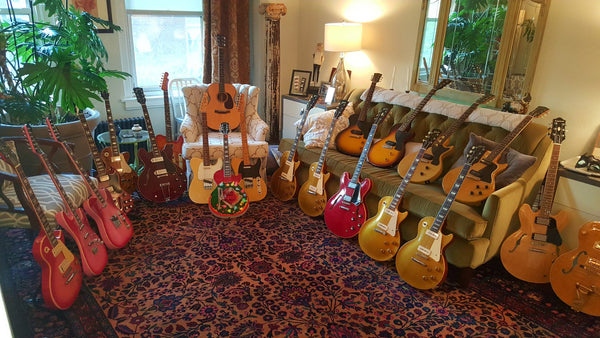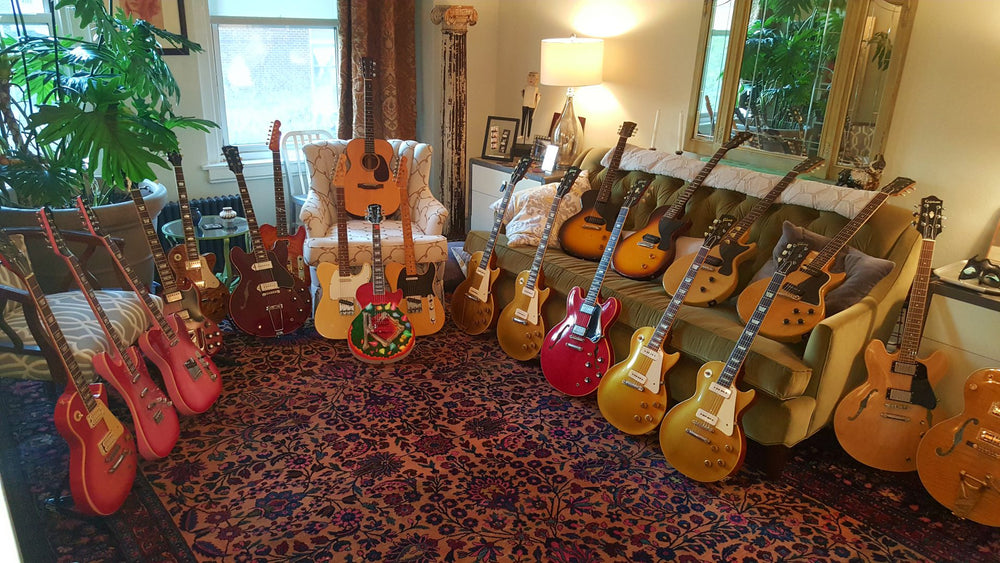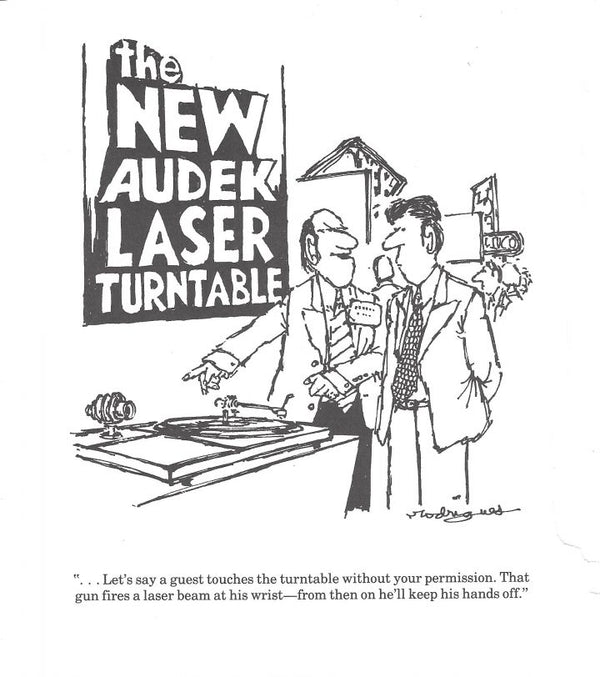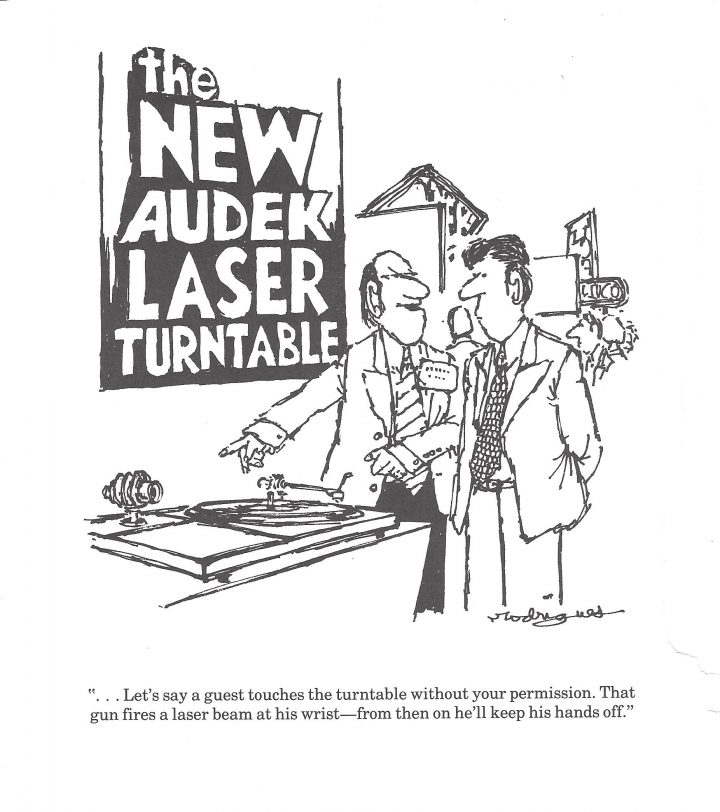Early on in my writing for Copper a few readers asked me to write about my influences. I understood that to be about the guitar players/bands that inspired me.There is, however, another part of that ‘influence’ and that is in the guitars that I play.
As high end audio tends, by and large, to be a long term passion to most of the readers here, I would expect it to be understood that there may be other passions that also started at about the same time (mid 1960’s).
Those for me would be:
- Rock ‘n’ roll in general, but the Beatles in particular.
- My fascination with, and the collecting of, electric guitars.
The other obsessions I have had are/were:
- Running (from 1980-1990 before injuries led to the end of this) including running and finishing 2 NYC Marathons.
- Wine (over the last 5 years)
- Watches ( over the last 5 years)
This article is about my guitar collection: what I own, have owned, and why.
Associated with this articles are 3 photos. The long shot is a photo of all the guitars in my house at the time the photo was taken and the other 2 are close ups of the same photo session.
Yes, these are guitar porn shots for those who know…
This may sound weird but I had no idea how many guitars I had at the time these photos were taken.
I had been contacted by the high end custom guitar manufacturer Juha Ruokangas, who wanted to do an interview (both video & audio) with me as I had Juha make me 4 of his guitars. I had read about Ruokangas guitars in a magazine article in The ToneQuest Report.
The ToneQuest Report is one of those super insider publications (no ads!) written by and for musicians who delve into the minutiae of guitar tone that readers of Copper would understand as an almost mirror-like fixation of their own audio addiction. The editor of ToneQuest, David Wilson, has become a good friend and I joke with him about his magazine being the “last stop on the Crazy town express for guitar nuts”.
Sounds familiar?
Anyway, David wrote about a boutique guitar company based in Finland called Ruokangas Guitars and I took the bait, contacted the owner Juha Ruokangas and had him build me a guitar, and then another and so on and so on.
See more about Ruokangas Guitars here:
Jay Jay French
Juha builds exquisite guitars but I digress…
Juha wanted to do a video about me and by extension, my guitar collection. The latter request, however, I didn’t know about until the video crew came over and wanted to see and film some of my guitars.
When they asked if I had any in my apartment, I said I thought I had about 10.
Well…I had way more in my apartment then I realized, 25 at the time (22 I found for the photo shoot and another 3 under beds afterwards.
I also have another 30 or so in various warehouses.
I started to go through my closets and pull them out.
Now, I can see how, since many of them are collectors items (and very valuable) you may ask yourself how I could not know how many I had.
Only a collector of these instruments may understand the explanation.
I have collected so many over 40 years that sometimes I don’t look at most of them for years or I pull them out to show close friends.
I can hear some of you howl..”How can you leave these in cases or at least have them displayed?”
The answer isn’t complicated. I don’t have room to display them all and I also don’t need to see them.
I pull some out from time to time to play them for a little while, however.
I probably have owned more than 500 guitars total since 1967. I currently have about 50 guitars and most pros I know (who also collect) have on average about 60 guitars per person. I have friends who have 600+.
Why?
Because we love them and have our own unique reasons as to why we own what we own.
For me, I own what I own because I started collection based on the guitars played by guitar players I admired and were photographed playing a particular model on their respective album covers.
The photos accompanying this article show the variety.
There are Gibsons (mostly), Fenders (a couple of Telecasters ), an Epiphone ES-335, a Gretsch 6120, a Martin 00-18 acoustic & 2 Ruokangas guitars.
My first real buy was in 1967. I wanted the guitar that Mike Bloomfield played on the debut Paul Butterfield Blues band album. A photo on the back really hit me and I wanted that guitar.
I went down to 48th street to Manhattan’s “music row” which is now, sadly completely gone, to buy the Fender Telecaster model that Bloomfield played.
I had $135.00 to spend.
I walked into Manny’s music (the original store located closer to 6th ave. and ironically was sitting on the exact spot of the Fox Morning News outdoor concert stage) and I met Henry, Manny’s son and then owner. I told him that I wanted to by the guitar. He told me that it was $147.50.
I told him that I only had $135.00. He told me to come back when I had the rest of the money.
Angry and frustrated, I walked directly across the street into another music store called Jimmy’s. I told the salesman that Manny’s wanted $147.50 but that I only had $135.00. The guy said “give me the $135.00 kid, here’s your guitar!”
And so, with that, I made my first of dozens of purchases on 48th Street! I had that guitar for about 6 months, then sold it.
6 years ago, on my 60th birthday, I had the opportunity to buy a perfect original 1967 Fender Tele (with case) fo $8,500.00 I bought it.
You can also see a real (not reissue) 1952 Fender Tele. I got that one about 15 years ago before the vintage craze started to make owning this stuff crazy.
I fell in love with Les Pauls because I heard that Eric Clapton played them. This was in 1966 and I thought that a “Les Paul” was a company not a model of a guitar made by Gibson Guitars. I became infatuated with their sound and quickly learned all I could about them.
With Cream, Clapton played a Gibson 1962 SG Les Paul painted a psychedelic motif by a group of artists called “The Fool”. When I saw Cream for the first time in 1967, Eric was playing it and I always lusted after one. I finally got one, in perfect all original condition, in 2003.
Interestingly, I never wanted the guitar models that the Beatles played (Rickenbacker, Hofner or Gretsches), nor did I care for a Fender Stratocaster ( the guitar of choice of Jimi Hendrix). I can’t exactly say why. I just never cared for them.
I did, however, wind up owning several “Strats’ over the years including a rare 1957 one and I own one (custom now. I also own a Gretsch. I really only ever lusted for Gibsons.
I collect ‘Gold Tops’ because I have an album cover of Freddy King playing one and it blew me away.
I bought my first Gibson Les Paul Gold Top in 1972. It was made in 1953. I traded a 1969 Gibson Les Paul Black Custom that I bought for $300.00 and $400.00 in cash for the Gold Top at the Music Inn on west 4th street in Manhattan
I collect Gibson Les Paul Juniors because Leslie West played. I saw Mountain 2 days before Woodstock and Leslie blew me away with the tone of his Les Paul Junior.
I bought my first Gibson Les Paul Junior on May 1st 1970 off a junkie in Central Park. (I made him sign a receipt and I overpaid!-$275.00).
Those who know, will know what they are looking at. To the rest of you: None of the guitars are vintage reissues. All are real and I collect, for the most part, pristine examples of the guitar models.
The Martin acoustic on the chair is a 1953 00-18, with the 2 Fenders Telecasters below. The Christmas wreath Les Paul is a 2013 Epiphone white Les Paul custom painted for use in our Christmas concerts.
To the left of the chair are a Pink Burst custom painted (by John Cruz) Fender Telecaster , a 1961 Gibson SG Les Paul, a 1967 Gibson Burgundy ES 330, and behind that, a Ruokangas sunburst Unicorn and next to that, a Ruokangas Mojo Grand.
I own a Red Gibson semi-hollow 335 because Clapton played one on the final Cream tour, and the 335 model may be the single greatest guitar that Gibson ever made. The pickups are original PAF’s (for those who know) and the nest and tone are,well, very Cream sounding!
At the extreme left of the big photo you will see a pink Les Paul. That was bought by me as new originally in 1978 and had a tobacco burst color. It was re-painted by a Long Island luthier named Steve Carr, who passed away many years ago. He became famous for building Gene Simmons’ first Axe bass for KISS. That Pink 1978 Gibson Les Paul can be heard on all Twisted Sister recordings.
The Gibson Les Paul Juniors are not pristine but all are original with no parts replaced.left to right by year: ‘56, ‘54, ‘58 and a ‘56 Les Paul Special
The Gibson Les Paul Gold Tops on the couch are (left to right) are by year: ‘52,’53’ 55’ 57.
To the right of the couch are great, but not vintage guitars: 1 new Epiphone ES 335 (natural finish) and 1 new Gretsch 6120 (natural finish)
In 1999 I was managing a band from Atlanta called Sevendust. One of the guitar players really liked Epiphone guitars. I got him an endorsement and became friends with the president, Jim Rosenberg. At the time, Twisted Sister had yet to reform but Jim told me that if I ever put the band back together again, to contact him and he would endorse me. Epiphone is owned by Gibson and are the only company allowed to make copies of Gibsons most famous models.
These guitar are built in either China or Indonesia in factories that are totally up to date. They make copies so well that I fell in love with the quality of Epiphone Les Paul’s. Furthermore these ‘copies’ sell for 20% of their American made cousins.
When Twisted reformed in 2003 I contacted Jim and not only started to play Epiphones, but Epiphone made my own Jay Jay French model Les Paul. These guitars were/are beautiful and I began playing Epiphone model Les Pauls exclusively for the next 14 years!
If you see photos of me on stage you will always see me playing my Epiphones. I no longer had to worry about carrying expensive Gibsons around that could get stolen, damaged or lost. They were perfect professional tools that always worked.
Maybe, at one of our local shows I played one of my very expensive vintage models but that happened once or twice in the 14 years that we returned to live performing.
Having said that, there is one guitar in my collection that I truly covet. If you ask me which of all these would be my desert Island guitar, the answer is easy:
My sunburst 1954 Gibson Les Paul Junior (second from the left on the couch) which I bought in 1984 for $325.00. It is by far, for me, the most perfect combination of tone and feel.
The guitar was made as an electric guitar ‘practice model’ and sold for $99.00 in 1954.
In contrast, the larger and more robustly built and painted Gibson Les Paul Standard that same year sold new for about $200.00
I have many great ones but that ‘little’ Les Paul Jr. is, well, the one!











































